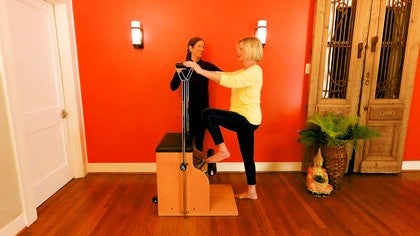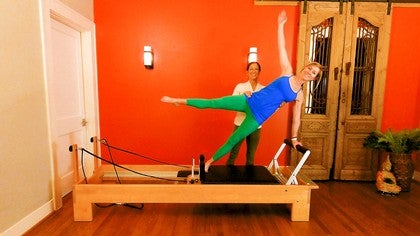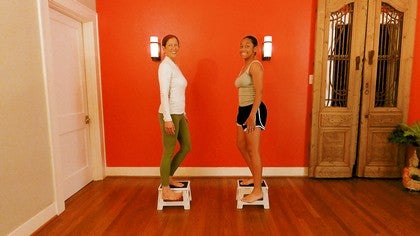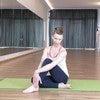Description
About This Video
Transcript
Read Full Transcript
Hi, I'm Dr. Sherrie Betz. And I have the privilege of working with Ariadne who's a gymnast and cheerleader. She does cheer competitions and tumbling. She came to me for knee pain and she also has a history of five ankle sprains on the left ankle. So I think that's maybe causing some of the trouble.
And there's a few things that we discovered about her when I went to her gym and watched her tumbling. So I'd like you to see some footage of her tumbling now. So here, you see that she's doing a roundoff back tuck. And when she lands, I'm gonna slow the motion down so you can see the valgus and the pronation of the feet, and the valgus of the knees and the pronation of the feet that happens. And that's a typical landing that Ariadne's been doing when she's doing any tumbling or jumping.
So we've been working on that and I'd love to share some of the results because she's been able to tumble without pain for the last couple of weeks. And we've only been working together about four or five times in the last month right before Christmas, and then coming up in the last couple of months. So yeah. She is doing much better and remembering her alignment much better, but she does have some biomechanical asymmetries and some difficulties with her ankle mobility that are feeding into some of the problems that she has with jumping and landing. It's really not the jumping that's the problem, it's the landing that's the problem.
So Ariadne, what I'd like you to do is come up onto the reformer. Now, I have all the springs on, and then I want you to stand up on the reformer and face this way and jump off. And then I want you to kind of just do it any old way. Don't think about all the corrections and just let's see what happens. Okay. And here she goes.
(floor thuds loudly) Okay. Now, let's do it one more time. And then I want you to land with your feet slightly apart this time. And let's see. (floor thuds loudly) Okay.
And what we wanna see is, or here is a little bit quieter landing and then straightening out of the foot. You can see that one of her feet actually migrates out to the side and I'll explain why that happens in just a moment, so. Okay. So we're gonna go on the reformer now, and I'd like you to lay down on your back. I'm gonna bring the headrest up and I'm just gonna take these off because they tend to jingle, jingle when they're hanging on there. And then I'm wanna have you place your feet on the footboard here, the jump board.
And I'm gonna take some of the springs off. Right now, all the springs were on because we had the reformer carriage lockdown. And I'm gonna start with about two red springs on there. So that's like medium tension. Let's separate your feet just a little bit. All right.
And now, go ahead and do a light jump. Mm-hmm. And so what I'm looking for is that she keeps the ankles in neutral, knees apart, and land softly. So point your toes as you lift and then roll through the foot, toe ball heel. Yes. Nice.
And again, repeat. And just keep going. And then I want you to land a little softer, a little softer. Mm-hmm. That's better. Roll through your feet. Keep going, couple more.
Excellent. So she's doing a really good job of keeping the ankles aligned and you'll see the close up footage of her doing this, and it looks really good. Okay. Now, bring one leg up and we're gonna let her jump on her right leg first. So right leg is the leg that's not as problematic and she doesn't have any pain in the right knee. So go ahead and push out.
And we'll see if she can do. Nice work. So the right foot usually is well-aligned. All right. Now, we're gonna switch to the other side. Bring your right knee to your chest and then extend out, jumping on the left.
Mm-hmm. Much better. Yes, that looks great. Mm-hmm. So there's a little bit of a bunion on this side too because she's really been spending a lot of time in that rolled in position with the arch collapsing and looking much better with that. Okay.
So now, I want you just put your feet up here for just a moment. And what I want you to see is when she flexes her ankles back, and you can usually see that she has much more flexibility on the right ankle than the left. So if I usually do a goniometric measurement, you're gonna see a difference of her range of motion. So let me show you what that looks like. So if I put the goniometer on the middle of her shin here, right at the ankle joint, and I put the other part of the goniometer at the lateral foot, and then pull back, I see that I can get her easily to about 10 degrees of dorsiflexion with her knee straight.
Now, when she bends her knee, it's gonna allow the calf to relieve its influence on the ankle. And so then, I can get the foot a little bit more into dorsiflexion, maybe get another five degrees. So she's got about 15 degrees there. Now, on this left side, you'll have to take my word for it. She has, basically, I can get her to zero degrees on this side.
I cannot get her any further back than zero degrees. And then if I push a little bit, possibly, I can get about five degrees of dorsiflexion. So she's limited at least 10 degrees. It'd be ideal if she had about 20 degrees of dorsiflexion on this ankle. Because she sprained it so many times, there is some limitation there.
So we've been doing a lot of ankle mobility work with that. Another thing that is causing her some trouble is the, her ability to extend through the great toe. And it's interesting. I asked her mother to come with her one day because I want to see if this was genetic and it is. Her mother has the same feet as she does.
And that's as far as she can extend the big toe, which is about, not even 45 degrees. So that really is difficult for her in tumbling when, especially when she's landing from a back handspring or a round off, or if she lands short, that big toe really gets either jammed into extension or it's really tough for her to land. And she'll end up rolling in through the ankles instead of dorsiflexion through the great toe. And same thing on this side. And then she's got the bunions that are more pronounced on the left than the right.
And the left side is the one that has more trouble. But anyway, you'll be able to see this in just a moment with some other things that we'll be doing. So we do varying spring tensions with the jumping. She likes to do it with light springs so she can fly a little bit and that's really fun. So let's do one with a lighter spring tension, I just do a red and a blue, and then extend your right leg out.
I know your right leg can do it. So let's see what your left leg does. And then go ahead and jump. Yeah. So she gets a little more air time and she has a little bit more time when she's just beginning this technique to figure out where she's gonna place her foot, how she's gonna keep her heel slightly lifted, and then keeping her knee in alignment so that she doesn't let that knee caving. Excellent. All right.
There's your fun. Okay. So I want you to roll to the side and come up and then we're gonna move onto the next exercise. All right. So now, we're gonna do a little bit of mat work and just kind of seeing how she moves in standing. So let's do a releve and let your, yes, just a natural way of doing it.
And you see how her ankles come apart. She sickles outward just a little bit. And now, try it with your heels together. Great. That looks good. There you go.
Mm-hmm. And you can see how that affects the knees too. She has a little bit of bowing of the legs, especially this left one. And she has a little bit of internal rotation of this leg as well that creates problems for that foot. Okay.
So now, what I want you to do is stand on your right leg, lift your left knee to a 90 degree angle and do a heel raise on that side, and just keep going a few times. That's it. Pressure's on. Three and four, five, six, seven, eight, nine, and ten. Okay. The other side. I'm gonna see if there's a difference right to left.
All right. One, two. Do you see the difference now she's rolling out on that left side? Mm-hmm. Okay. So I want you to stop now and I'm gonna give you a little tool to help you.
So I want you to put this dowel on your left side here, and then I'm gonna get right back here and see what's going on. All right. Now, stand on your left leg and rise up and I'll give you some cues. Okay. Yes, that's already better. I want you to put a little bit more weight to the, actually, the inside of your foot.
Mm-hmm. Just a little bit. And rise up. And this is where we might use a mirror too for her. Yes, that would be good.
That looks great. So it's not as high as it was when you were rolling outward, right? That she was cheating to get the height of the heel. So that looks really good. Now, what I want you to do is just keep your feet together and then bend your knees as much as you can. Mm-hmm.
All right. Turn to the side and do that same thing. Okay. And watch. And you can see the difference between how much her knees bend and how much my knees bend. So you can see that's a degree of dorsiflexion. If your trunk is vertical and you bend, actually your ankles are what is going to limit you from descending all the way down.
Right. So coming back up. Now, stand on just your left leg and lift your right knee. And I want you to bend again. Mm-hmm. And, yeah. So that's, you barely got any, right?
It's just a little bit. Do it again just a little bit. Great. That looks good. Uh-huh. All right.
So we know that the limitation is ankle dorsiflexion. So I'm gonna have you go over here to the door, and I want you to put your hands up on the door and put your left foot up against the door. Mm-hmm. And so now, you're gonna stretch the big toe back and try to get the ball of your foot against the door. Mm-hmm.
And then I want you to bend your knee. That's it. So she's stretching both the great toe and the ankle here, just the tail curl joint. And nice. Yes, that's it. So that's a great stretch for her to do because it doesn't really involve the calf and it gets both of her issues at one time.
That looks really good. Excellent. Okay. Now, come back and stand here. And I want you to put your dowel in the right hand. Step forward with your right foot.
And I want you to step about 36 inches or so, three feet or so. There you go. A little bit further. Okay. Now, keeping this back foot parallel, rise up on your tip toe. Mm-hmm. And then what I'm gonna show you in just a moment is that, that ankle's rolling out quite a bit because she's limited in that great toe dorsiflexion.
So I'm gonna have you come back to center now. That's great. And put it back down. Okay. Now, come together and turn and face the camera so that the folks at home can see this. Put your right foot straight ahead. Okay. And now, rise up on that toe and that's it.
And the way you did it before was like that, turning it out and kinda letting that ankle roll out. So that's the reason that she's had these ankle sprains is because not because her ankle is not as mobile, but her great toe requires her to roll out because she can't get up high on that foot. So if we can keep that foot point straight ahead and then lift up and really get her to keep the heel centered over the second and third toes and stretch that great toe dorsiflexion, then go ahead and bend down into a lunge as far as you can. There you go. And just, don't go all the way down.
Because as soon as she goes all the way down, she's gotta tilt her trunk forward in order to get that toe to extend. Okay. Come back up. Excellent. All right. Step together. So you can kind of see some of the issues and why she's having trouble with the landing.
All right. Now, we have brought the step stools out and I'm gonna show you a really interesting way to look at how dorsiflexion affects the knee bending here. Okay. So we're gonna step onto the stool right in the center of it, flex the foot, and then I want you to bend your knee until your heel touches the ground. So you can reach your arms out if you need to. And I want you to try to keep your torso vertical, and you can see that I'm keeping my pelvis pretty level. I have enough dorsiflexion to get there.
And for her, she has to bend forward in order to get there. Try to keep your foot flex so you just touch her heel to the ground. And so you can see how she has to bend her trunk forward in order to get her heel to the ground. Right. So let's do this. We'll give her two blocks.
And then try again. Yes, that's great. Now, she can do that because she has enough dorsiflexion to get there and she can stay vertical. Great job. So really simple little demonstration.
Now, turn around. And then I'm gonna have you do it on your left side, and we'll put the blocks on this side and let's see the difference. Okay. So, all right. Pull the foot up and touch your heel to the ground.
So this is her left foot on the stool. And you see the compensation. She can't get there with this side. So there's so much less dorsiflexion of that left ankle that she ends up tilting forward and arching the back and dropping the pelvis to get down there. Okay, good. Let's work on that.
Stepping down. All right. And we'll bring the chair in now to have her do some work on the Combo Chair. All right. Now, we're gonna have Ariadne work on the Combo Chair doing the forward and sideward lunge. So go ahead and step in front of the platform here, place your hands on the handles, and then as you place your foot on the pedal, be mindful of how your posture is.
So lifting up and placing the foot on the pedal. Press the pedal down with your heel lifted. Only watching how she puts weight through that foot. And then I want you to step your left foot up here all the way to the back of the platform. Mm-hmm. Perfect.
All right. And then the pedal's gonna help you come up. So let it allow the pedal to help you come up and stand up all the way exactly. So we're just looking to see what is this foot doing? So I'm mostly watching that left foot and then go ahead and step down. Uh-huh.
And then watching to see what happens there. And you can see there that she's, most of her weight is on the inside of that foot. And so what I want you to think about is that you keep your knee aiming towards your fourth and fifth toe and your arch lifted. All right. So let's try it again. Rising up.
Mm-hmm. Better. Makes it harder, doesn't it? So now, her pelvis dropped a little bit on that side, so that looks good though. And then sometimes they don't have enough dorsiflexion to be able to do that. So the cue I'm gonna give her is to push into my hand with her left knee.
So go ahead, pressing up, keep that pressure on my left. Yes, that's right. Good. All right. And then take it back down and I'm gonna have you stop when you're at the top of the movement. This time, you don't have to go all the way up.
Breathe in. Breathe out to take it up, pressing up. Great. That looks good. Keep pressing into my hands. She's letting that knee roll in a little bit.
That's it. And press into my hand as you come down. Excellent. That's it. So we're really getting that gluteus medius to work, and then maybe even lift your big toe on this side. Try lifting that big toe and then let's try it again and stop when the pedal is at the top and you don't have to come all the way off of it this time. Just stop at the top.
There you go. Keep pressing into my hand. That's it. Great. Okay. Now, come halfway down and then I want you to just pump this ankle. So you're gonna bend that knee and just pump in place.
Great. And keep that pressure on my hand. There you go. Four and five, six, seven, eight, nine, and ten. Excellent. Now, go all the way up to standing. Mm-hmm. Keep that pressure on my hand.
Then step all the way up onto the platform. And now, what I want you to do is put your left foot here. So notice that I'm keeping her left foot and weight bearing and turn and face that way. Mm-hmm. And you're gonna put it on the diagonal like that, just like that.
Okay. Now, this foot is gonna come right past the split in the pedal. Mm-hmm, just like that. And then, mm-hmm, and turn the foot outward just a little bit so that when you come down, it'll fit on there a little bit better. Great.
Okay. Now, let's get you set up for success. We're gonna take the body upright. That's good. Okay. Now, I need that knee to come out a little bit. I'm gonna put my hand here in the back here and press against the outside of her knee so that she gets that cue to hold that knee out.
And this gluteus medius is already shaking. Okay. Right? Okay. Now, come down. Let the pedal go all the way to the ground.
Shift your weight over a little bit. Okay. And try to keep, now, adjust your foot on this pedal so it doesn't feel like it's slipping and then rise up on the releve position, lifting up, turning the foot out. Just a little bit more. There you go. Like that.
Now, see if you can keep your pelvis and your body facing the front. Mm-hmm. Here you go. Now, rise up. Take it up. That looks good. Yes, much better. Bring this rib cage back and your shoulders back.
That's it. Try to stay vertical, press into my hand here. Yes, I'm like an octopus here. And then take it down. Excellent. That's great, Ariadne. Better.
And then press it up, really reaching up. Excellent. Okay. Keep that knee pushing out into my hand. Mm-hmm. Good.
Yes, that external rotator of the hip is really helpful in controlling the knee direction over the toe. Great job. That looks good. Now, see her heel coming up. When the heel comes up like that, she's running out of range of motion and strength. Okay. So I'm gonna let you turn around.
She's fatigued now. It didn't take much, right? Step back onto the pedal. Uh-huh. And then come all the way down. Great job.
All right, go ahead and step all the way down. Graceful dismount. Let the pedal come up. All right. Now, I've turned the chair sideways so that you can see what I'm doing when I'm correcting her knee. I wanted you to see the cues that I'm using to help her correct the knee and ankle alignment. So if you can face the chair, place your hands on the handles, and then place one foot on the pedal and push it down.
Keeping the heel lifted of the leg that you're using to push the pedal down. That looks really good. And then step up with your left foot onto the platform at the end. So, especially since she has limited ankle dorsiflexion, I need her foot to be all the way at the end of the platform as far as forward as it can go. And that way, she doesn't have to have as much dorsiflexion to get all the way to the top.
So now, take yourself up with a pelvis neutral position. So pelvic headlight straight ahead, collarbone headlight straight ahead. Try to be vertical in your trunk and go straight up. Okay. And then, yes, that's good. And you can shift forward a little bit.
Mm-hmm. And then get over that standing leg. Okay. So what she tends to do is roll that knee inward. And I'm gonna come to the front here and the arch is flat just a little bit. So when she bends to come down, and go ahead and step down.
I'm gonna push into that left knee, and I want you to push into my hand. So I'm just using a light pressure on the outside of her left knee and then pressing up. Okay. Press up, rise up. Yes. Excellent. Mm-hmm. And then I'm gonna a have you step onto the platform with your right foot and move this foot straight ahead.
It's kind of twisting out just a little bit. And now, go ahead and step back. That looks good. And then push into my hand. 'Cause when she pushes into the hand and she controls the knee using her hip muscles that don't have any injuries and doing really well, she keeps the arch lifted and the foot pointed straight ahead.
So let's do that again, pressing out and rise up. Excellent. That looks great. All right. One more, coming all the way down. Oh, she wants to twist that foot again. (laughs) Gotta keep that foot straight ahead. There you go. Excellent. Okay.
Go ahead and step down, and come all the way down and let the pedal come up. Well done you. All right. Now, we're gonna see the results of our labor, our fruits of our labor, and see how she does with jumping. Now, we're gonna bring Ariadne back to where we started, looking at her jumping off of the box here.
We did jump off the reformer at first, but we had the springs locked down. The box is nearly the same height as the reformer. And we can use that very easily for her to jump off of to test her abilities. Go ahead and step up onto the box, and then stand with your feet about parallel. Yes. Hip width the apart.
And then let's do your jump and see how you do, okay? So do your best keeping the knees apart. (floor thuds softly) Uh-huh. She's landing more quietly and with better alignment. That left foot still wants to turn out just a little bit. So go ahead and do it again and let's see what you got.
I'm gonna get myself so I can see a little bit better in front of her here. And now, go ahead. (floor thuds softly) Yes. Nice. That looks so much better. Really, really good.
All right. So what I wanted to say about Ariadne's situation is that I wanna keep her tumbling, doing the things she loves, doing her cheer competitions, being able to tumble, and feel that she's having a great time and that she's not worried about the knee pain. I want that to get to be a natural movement for her, that she knows how to position her foot. And so we practice in many, many different positions, really establishing those motor patterns in her brain. But the other reason I think this is so important is that this is the main time that children build bone density.
So between age 10 and age 20 is the main window for what we call the magic window for bone building in children. So what she does as a child or as a young adult here will serve her really well in the future. Because what we say about osteoporosis is that it's a pediatric condition with geriatric manifestations. So if she can't run and jump and tumble, that is going to be a detriment for her bone health in the future. So thank you for letting me work with you.
This is really fun. Hope you do well in your cheer competitions, and look forward to seeing you next week. Thank you. Thanks for joining us. I hope you enjoyed the tutorial.
Bone Health - Playlist 4: Osteoporosis and Exercise
Comments
One quick question: at one point you're cueing for Ariadne to keep the knee over the fourth and fifth toe. Is that so she can compensate for the knee turning inwards? I thought that usually the knees should go over the second and third toe.
You need to be a subscriber to post a comment.
Please Log In or Create an Account to start your free trial.
















